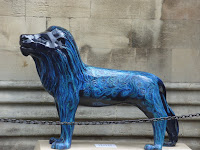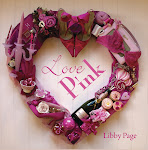There are 100 lions currently roaming the streets, parks, shops and rooftops of Bath city centre - But don't be afraid, they are very friendly lions...They stand quite still when you approach and they are very photogenic...
My eldest daughter and I had an afternoon in Bath yesterday, having a mooch around the shops and generally enjoying a bit of time-off. I must admit that I did embarrass her a few times taking photos of some of the lions, particularly when I would cross a road especially to do so...but Blogging is far too much under my skin now, so never to miss a photo opportunity...here are a few of my quick snaps...(taken as discreetly as possible, so as not to cause my daughter too many red cheeks! ;-))










*******
There's rather a magnificent beast that's been given pride of place in my shop's window too...
Isn't he a beauty? He's already caused quite a stir and I hope to find him a new home very soon...
And this little treasure too, which, along with the rocking horse, has come from the same lovely lady. These are both quite rare items to come up for sale, so I am very hopeful that they will be snapped up quickly and will soon be with new and appreciative homes.
I am very pleased to try to sell these for my friend - I was busy with the market on Sunday, so was unable to go out on my usual hunt for stock...I did however find these two beauties whilst out with my daughter yesterday...
Both from the 1950's; there's a handmade cotton floral skirt...
And a fabulous rose printed summer dress.
They were added to my shop today, where I had some surprise visitors...My parents, who haven't seen my shop before as they live on the other side of the country, called in to surprise me on their way to stay with my Aunt and Uncle. Mum and Dad are due to come and stay with us from Friday onwards, on their way back home, so I wasn't expecting to see them before then.
I know Mum doesn't quite understand my love of the 1950's clothes that I found, as she wore them the first time round...but isn't that what nostalgia is all about? I remember seeing photos of her and my Nan dressed in beautiful floral print dresses that they had made themselves, and so when I find clothes from that era, it brings back to me those images of them both in an instant.
In fact last week I was talking to one of my customers about the same thing. She had just been reading an old copy of Three Men in a Boat, by Jerome K. Jerome, which was written back in 1889, and one particular chapter had stuck in her mind. The next day she came in to see me again with two pieces of paper, on which she had hand written a whole section from Chapter 4. It talked of the collectables of today in such a way, it is difficult to believe that it wasn't written in more recent times, as the foresight of its contents could not be more spot on...
If you've not read it yourself before, I include here the paragraphs that she so kindly wrote down for me:
"...they must have had very fair notions of the artistic and the beautiful, our great-great-grandfathers. Why, all our art treasures of to-day are only the dug-up commonplaces of three or four hundred years ago. I wonder if there is real intrinsic beauty in the old soup-plates, beer-mugs, and candle-snuffers that we prize so now, or if it is only the halo of age glowing around them that gives them their charms in our eyes. The “old blue” that we hang about our walls as ornaments were the common every-day household utensils of a few centuries ago; and the pink shepherds and the yellow shepherdesses that we hand round now for all our friends to gush over, and pretend they understand, were the unvalued mantel-ornaments that the mother of the eighteenth century would have given the baby to suck when he cried.
Will it be the same in the future? Will the prized treasures of to-day always be the cheap trifles of the day before? Will rows of our willow- pattern dinner-plates be ranged above the chimneypieces of the great in the years 2000 and odd? Will the white cups with the gold rim and the beautiful gold flower inside (species unknown), that our Sarah Janes now break in sheer light-heartedness of spirit, be carefully mended, and stood upon a bracket, and dusted only by the lady of the house?
That china dog that ornaments the bedroom of my furnished lodgings. It is a white dog. Its eyes blue. Its nose is a delicate red, with spots. Its head is painfully erect, its expression is amiability carried to verge of imbecility. I do not admire it myself. Considered as a work of art, I may say it irritates me. Thoughtless friends jeer at it, and even my landlady herself has no admiration for it, and excuses its presence by the circumstance that her aunt gave it to her.
But in 200 years’ time it is more than probable that that dog will be dug up from somewhere or other, minus its legs, and with its tail broken, and will be sold for old china, and put in a glass cabinet. And people will pass it round, and admire it. They will be struck by the wonderful depth of the colour on the nose, and speculate as to how beautiful the bit of the tail that is lost no doubt was.
We, in this age, do not see the beauty of that dog. We are too familiar with it. It is like the sunset and the stars: we are not awed by their loveliness because they are common to our eyes. So it is with that china dog. In 2288 people will gush over it. The making of such dogs will have become a lost art. Our descendants will wonder how we did it, and say how clever we were. We shall be referred to lovingly as “those grand old artists that flourished in the nineteenth century, and produced those china dogs.”
The “sampler” that the eldest daughter did at school will be spoken of as “tapestry of the Victorian era,” and be almost priceless. The blue-and- white mugs of the present-day roadside inn will be hunted up, all cracked and chipped, and sold for their weight in gold, and rich people will use them for claret cups; and travellers from Japan will buy up all the “Presents from Ramsgate,” and “Souvenirs of Margate,” that may have escaped destruction, and take them back to Jedo as ancient English curios."
Will it be the same in the future? Will the prized treasures of to-day always be the cheap trifles of the day before? Will rows of our willow- pattern dinner-plates be ranged above the chimneypieces of the great in the years 2000 and odd? Will the white cups with the gold rim and the beautiful gold flower inside (species unknown), that our Sarah Janes now break in sheer light-heartedness of spirit, be carefully mended, and stood upon a bracket, and dusted only by the lady of the house?
That china dog that ornaments the bedroom of my furnished lodgings. It is a white dog. Its eyes blue. Its nose is a delicate red, with spots. Its head is painfully erect, its expression is amiability carried to verge of imbecility. I do not admire it myself. Considered as a work of art, I may say it irritates me. Thoughtless friends jeer at it, and even my landlady herself has no admiration for it, and excuses its presence by the circumstance that her aunt gave it to her.
But in 200 years’ time it is more than probable that that dog will be dug up from somewhere or other, minus its legs, and with its tail broken, and will be sold for old china, and put in a glass cabinet. And people will pass it round, and admire it. They will be struck by the wonderful depth of the colour on the nose, and speculate as to how beautiful the bit of the tail that is lost no doubt was.
We, in this age, do not see the beauty of that dog. We are too familiar with it. It is like the sunset and the stars: we are not awed by their loveliness because they are common to our eyes. So it is with that china dog. In 2288 people will gush over it. The making of such dogs will have become a lost art. Our descendants will wonder how we did it, and say how clever we were. We shall be referred to lovingly as “those grand old artists that flourished in the nineteenth century, and produced those china dogs.”
The “sampler” that the eldest daughter did at school will be spoken of as “tapestry of the Victorian era,” and be almost priceless. The blue-and- white mugs of the present-day roadside inn will be hunted up, all cracked and chipped, and sold for their weight in gold, and rich people will use them for claret cups; and travellers from Japan will buy up all the “Presents from Ramsgate,” and “Souvenirs of Margate,” that may have escaped destruction, and take them back to Jedo as ancient English curios."
**
Last, but not least, my thanks to Sal for visiting my shop and for her kind post.
Niki x


















































That is a sweet Leeways horse you have there, one of the better carved ones, how much is he? Jane x
ReplyDeleteWow, I love that dress and the skirt is stunning, I have just got myself a 1950's dress from a shop called V for Vintage near where I live. It is very similar to the dress.
ReplyDeleteNicky x
Hi Niki! ;o)
ReplyDeleteI saw many lions, on my last holiday to England and I wondered what they mean, now I know, thanks!
Beautiful photographs, make the company!
A dear greeting, Maria.
The quote from 'Three Men In A Boat' is fascinating: thanks for taking the trouble to type it out - there is nothing new in the antiques world, including the love of antiques! Incidentally, yesterday was the actual date in the film 'Back To The Future' according to my son, who is now nostalgic for the 80s which was actually before he was born! Best rgds, Carol x
ReplyDeleteHi Niki
ReplyDeleteWhat a makeover! Now if you ever decide you need to part with the cupboard that was in the kitchen which is now where the armoire was ... you know it will match mine perfectly and I'm sure I could find room for it!!!
Sue xx
Over here in Toronto, Canada we have moose statues everywhere, similar to your lions.
ReplyDeleteAmazing how that author got it exactly right! ...and to think that quote is already more than 100 yrs old. thanks for takingthe time to let us all read it.
hugs Karin
P.S. the trike & rocking horse won't last long I'm sure!